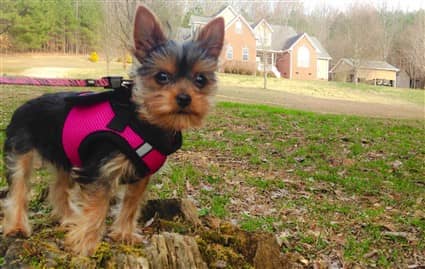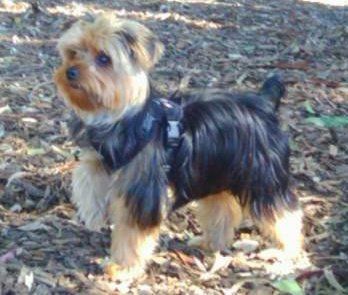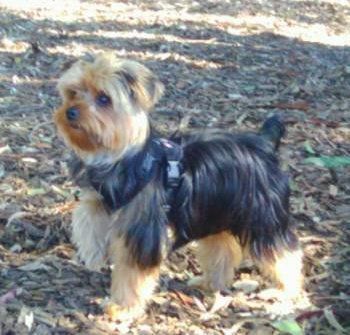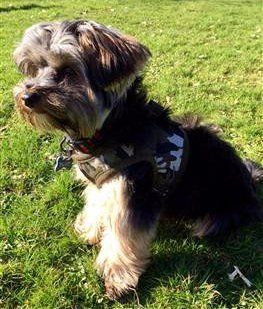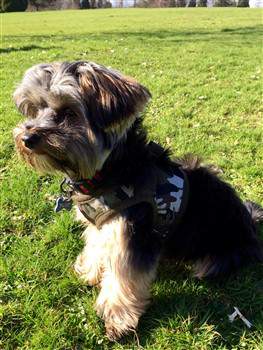Yorkshire Terrier Collars & Harnesses
Molly, at 4 months old, photo courtesy of The Massingills
Overview
When it comes to accessories for your Yorkie, there is perhaps nothing more important than the collar and harness that you choose. Using a harness can most certainly affect such elements such as having good control that leads to your Yorkie walking properly beside you, however it goes far beyond that.
The best collars and harnesses for Yorkshire Terriers will actually help prevent serious health conditions that can affect a dog's quality of life.
Please note:
YorkieInfoCenter is reader-supported, and some of the product suggestions on this page are affiliate links. As an Amazon Associate we earn from qualifying purchases. This is at no extra cost to you and helps us continue providing free, high-quality information.
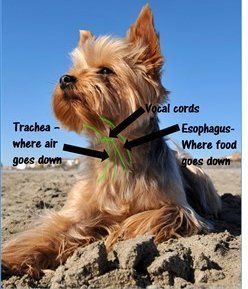
Understanding Canine Neck Anatomy
Before we cover which collars or harnesses are best for the Yorkie, it is important to have an understanding of a dog's neck.
Right under the vocal cords, the throat splits off into two sections. The trachea which is toward the front of a dog's neck travels to his lungs. The other tube, the esophagus, travels into the stomach. The trachea is not protected by bone. It is encased by rings of cartilage. Cartilage is not hard and rigid like bone, it is softer, flexible to a certain extent and importantly, much thinner.
Collars VS Harnesses
If on collar and leash, pressure is placed onto the trachea. And any time that the dog moves forward ahead of his owner and the leash goes taunt, added force is put onto the neck. In addition, if a Yorkie jumps to the side or makes other quick movements, more tension immediately is transferred to the neck.
So, aren't dogs' necks able to handle this?
Many can. However, brachycephalic breeds (flat faced, such as the Pug, Shih Tzu and French bulldog) have trouble with this sort of pressure and toy breeds, such as the Chihuahua, Maltese and you guessed it, Yorkshire Terrier, can have trouble due to being very small and having very little muscular support around the neck area.
What can happen?
There can be a general wearing down, which can cause neurological problems and neck issues. When force is suddenly applied to the neck, as can happen when on leash and collar, this can trigger collapsed trachea. As the name implies, the rings of the trachea collapse inward.
While this will happen more often to dogs that are prone to this (born with weak trachea), any dogs may suffer from this injury. This can be terribly painful and take a long time to heal. Some dogs will require surgery and others will never recover. Signs include a cough, trouble eating, intolerance for exercise
and wheezing noises.
What to do
- This is where the huge difference between collars and harnesses come in. A harness is your other choice for an accessory to connect the leash to. Very opposite to collars, a harness fits around a dog's upper back, shoulders and chest, where he has both bones and more muscles to handle the tension that may occur when he is being walked.
Kai | 5 years old | Owner: Carolyn
About Harnesses
There are several types of harness, both in the actual fashioning of the piece and how it is placed onto a dog. There are two basic types:
Strap harness
- Pictured here (left, below on mobile) is the strap harness. It is placed on a puppy or dog via buckles. These may be on the sides and/or upper back. If you opt for a strap harness, you will of course want to choose one that is appropriately sized for toy breeds.
Since one size does not fit all, you'll find that an adjustable harness is best. While these can be found in all sorts of materials, you'll want to choose a nylon webbing, as these are incredibly durable, are weather resistant and are very easy to clean. In addition, they retain their shape (unlike leather ones) and are breathable and light.
Just like clothes for Yorkies, you may find that your puppy or dog actually enjoys wearing a harness, as it offers a wrapping effect that many dogs find comforting.
Wrap / Vest Harness
- This is another great option, shown in the photo to the right (below on mobile). These are like tiny vests that the Yorkie wears and the connector for the leash is on the upper back just like the strap harness. As you can see, with either option, there is room for the collar, should you still wish to have your Yorkie wear one for identification purposes.
We recommend one that is fastened via velcro flaps or nylon straps that have a quick release buckle. With either option, it is really easy to place onto a puppy or dog, secure it to fit perfectly and then have it stay in place.
Look for a durable material that is weather resistant, durable and washable.
Since a harness like this is also doubling for clothing, you may be choosy about colors. One of the harness that are best for tiny breeds like the Yorkie, the Puppia, comes in 12 colors, including this camo design. Others are beige, black, brown, green, orange, pink, purple, red, royal blue, sky blue and yellow.
Both options allow a dog freedom of movement while keeping the neck free from injury. And both options are not only just tolerated well, they are actually loved by many dogs once they get used to them.
Beau at 10 months old
Photo courtesy of the Stewart's
Collars
Even if you use a harness for your Yorkie, you may still opt for him or her to wear a collar; this is essentially to hold the ID tag to help identify your dog should he become lost. According to a poll by the American Society for the Prevention of Cruelty to Animals, 15% of dog owners reported that their pet had become lost during the past 5 years.
Cappy, at 6 years old; Photo courtesy of Hilda
Fortunately, 93% were recovered. However, in looking at statistics over the entire U.S., a family pet is lost about every 2 seconds. Throughout the country, 542,000 dogs are brought in as strays and of those, just 26% are returned to their owner.
Even dogs that normally do not dart off can have a random urge to run. In many cases, it is caused by hormones; unspayed females may run off to find a mate and un-fixed males may escape if they smell a female in heat (canines can sense this from up to 3 miles away).
So, making sure that your Yorkie wears an ID tag (or having him micro-chipped) can offer some sense of security.
When choosing your Yorkie's collar, do keep in mind its weight; the lighter the better while, of course, still being durable. As with harnesses, leather can look really nice but really tends to stretch out over time and can become misshapen if it gets wet.
For growing puppies, check the adjustment once per week; a rapid growth spurt can cause the collar to cut into the skin. For Yorkies of all ages, you will want to be able to slip 2 fingers under the collar.
Recommended Harnesses for Yorkies that Actually Fit
Finding accessories that fit this tiny breed can be a challenge if you are not sure where to look. However, the Puppia harness is one of the most popular ones that actually fits,is adjustable, is incredibly easy to use, is durable and is super comfortable.
For a step-in strap option, look to the EZHarness by Dexdog, it comes in 6 colors and literally only takes seconds to slip on and off.
Keep In Mind
Since your Yorkie will be walked at least once a day (twice is recommended), what you choose to attach the leash to is vital both now and for years to come. Please reassess if you are using the right accessory; once neck injury occurs, it is too late to go back and wish that you had made changes.

